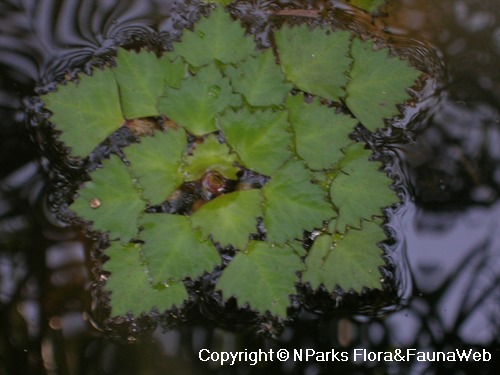
Back
Trapa natans
| Family Name: | Trapaceae |
| Synonyms: | Trapa bicornis Osbeck |
| Common Name: | Water Caltrop, European Water Chestnut, Water Chestnut, Jesuits' Nut, 菱角, 欧菱, 红菱 |
Name
Classifications and Characteristics
| Plant Division | Angiosperms (Flowering Seed Plants) |
|---|---|
| Plant Growth Form | Aquatic & Hydrophyte (Floating Aquatic, Emergent Aquatic) |
| Lifespan (in Singapore) | Perennial |
| Mode of Nutrition | Autotrophic |
Biogeography
| Native Distribution | Asia |
|---|---|
| Native Habitat | Aquatic (Freshwater Pond / Lake / River) |
| Preferred Climate Zone | Tropical |
Description and Ethnobotany
| Growth Form | An annual aquatic floater. |
|---|---|
| Roots | Branch roots anchor plant |
| Foliage | The plant produces linear, submerged and floating, rhombodial leaves with dentate margins which are arranged in rosettes up to 50cm in diameter. Each floating leaf has a petiole slightly filled with air to enable the leaves to float. |
| Stems | Spongy, cord-like stems provide buoyancy. |
| Flowers | The flower is small and has 4 petals. |
| Fruit | Has 2 conspicuous, sharp pointed horns on opposite sides. The viable fruit turns greenish-brown when mature and will sink down into the soil. The old fruits are will instead, float to the surface and are not viable. |
| Habitat | It is found in shallow, nutrient rich water bodies with still or slow-moving water. |
| Cultivation | It is ideally grown in a water pH of 6.0 to 7.2 and in water temperature of 18 to 28°C. |
| Ethnobotanical Uses | Edible Plant Parts : Edible Seeds Food (Fruit or Vegetable): The edible kernel has good starch content. In China, Japan and Korea, it is boiled, preserved in honey or used in local dishes. In India it is ground into flour. It is also eaten during the Chinese Mid-Autumn Festival. Medicinal: Fruits of the Trapa natans plant have anti-inflammatory properties and are used in making liniments purportedly as a cure of elephantiasis, rheumatism, sores and sunburn. It is also said to have cancer-preventing properties. |
Landscaping Features
| Desirable Plant Features | Ornamental Flowers, Ornamental Foliage |
|---|---|
| Landscape Uses | Pond / Lake / River |
| Thematic Landscaping | Water Garden |
| Usage Hazard - Cons | Invasive / Potentially Invasive |
Plant Care and Propagation
| Light Preference | Semi-Shade |
|---|---|
| Water Preference | Lots of Water |
| Rootzone Tolerance | Alkaline high pH Soils |
| Potential Problems | Vigorous growth, is a potential invasive weed in slow moving waters. |
Foliar
| Foliage Retention | Evergreen |
|---|---|
| Mature Foliage Colour(s) | Green |
| Mature Foliage Texture(s) | Smooth, Glossy / Shiny |
| Foliar Arrangement Along Stem | Rosulate / Rosette |
| Foliar Shape(s) | Non-Palm Foliage (Deltoid) |
| Foliar Margin | Dentate |
| Foliar Apex - Tip | Acute |
| Foliar Base | Truncate / Square |
Non - Foliar and Storage
| Stem Type & Modification | Herbaceous |
|---|
Floral (Angiosperm)
| Flower & Plant Sexuality | Bisexual Flowers |
| Flower Colour(s) | White |
|---|---|
| Flower Grouping | Solitary |
Fruit, Seed and Spore
| Mature Fruit Colour(s) | Brown |
|---|---|
| Mature Fruit Texture(s) | Smooth |
| Fruit Type | Indehiscent Dry Fruit , Nut / Nutlet |
| Mature Seed Colour(s) | White |
| Seed Quantity Per Fruit | Few (1-5) |
Image Repository
Others
| Master ID | 1236 |
|---|---|
| Species ID | 2529 |
| Flora Disclaimer | The information in this website has been compiled from reliable sources, such as reference works on medicinal plants. It is not a substitute for medical advice or treatment and NParks does not purport to provide any medical advice. Readers should always consult his/her physician before using or consuming a plant for medicinal purposes. |





